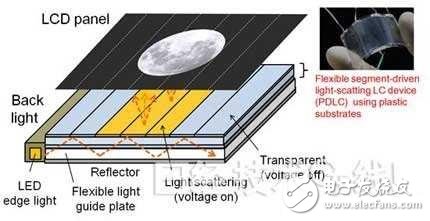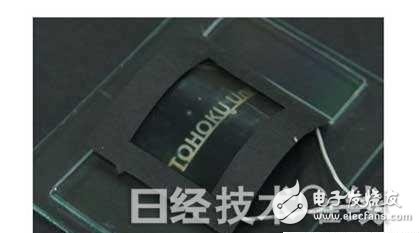1 Introduction
This article will introduce the topic of organic EL display, the mainstream of flexible panels in LCD panels, at 22th InternaTIonal Display Workshops (IDW '15), the largest international conference on display in Asia. Focusing on the research results of the rattan stone pot research laboratory at Tohoku University, Japan, together with the basic technology, will be explained.
2. Bending the LCD screen can also maintain the substrate spacing in various flat panel displays (FPDs). The organic EL display can achieve high contrast, high color expression range, and is easy to achieve ultra-thin, thus serving as a flexible display. Mainstream technology has been paid attention to, and the author has also introduced this in previous articles.
A representative electronic paper, the electrophoretic display (EPD), has long been put into practical use as a flexible display. Moreover, the display screen is a reflective type that is memory-free and does not require a backlight, and does not require a polarizing plate, so that a bright, achromatic display can be obtained. However, there are problems in color display and video display. This has also been introduced before.
The liquid crystal display can realize large screen, high definition, and can realize a large color expression range, and has been widely used as a high-quality display. Moreover, the manufacturing technology of the LCD screen is very mature, and it will not be long before China's output will become the first. However, liquid crystals are liquids at all, and must be arranged in an orderly manner. Therefore, with the development of extremely thinning and flexibility, liquid crystal panels have a problem in stabilizing display quality.
Figure 1 is the basic structure of a flexible liquid crystal display. In order to realize a practical flexible liquid crystal display, the focus is to utilize a network structure of a fine polymer spacer wall formed in the liquid crystal cell to maintain a certain cell gap and maintain a stable orientation. In the rattan stone pot research laboratory of the Tohoku University of Japan, by dissolving a molecularly oriented polymer material (resin) in a liquid crystal and exposing the ultraviolet pattern, it is possible to develop a high dielectric bonding without breaking the liquid crystal orientation. Molecular partitions were presented under the heading "Invited Advanced Polymer and LC Technologies for High Quality Flexible Displays" (Paper No. FLX2/LCT5-1). The "Bonding polymer wall spacer" of Figure 1 is the polymer partition wall they developed.

Figure 1: Basic structure of a flexible liquid crystal display (data provided by Tohoku University, Japan)
Moreover, flexible liquid crystal displays require flexible backlights. FIG. 2 is a partial dimming backlight system in which a liquid crystal polymer composite film is used in a light guide plate for a backlight that can realize thinness and flexibility, and contributes to high contrast and power saving. Both the liquid crystal and the polymer in the composite film have a molecular orientation, and can exhibit a light scattering or a transparent state by a switching voltage.

Figure 2: Flexible thin local dimming backlight system
In addition, the local dimming backlight automatically controls the brightness of the local backlight according to the image, and has the function of reducing the power consumption and improving the image contrast. It also suppresses the phenomenon of "whitening" of the black portion of the image. In FIG. 2, the voltage of the region where the image shows "moon" is "ON", which is "light scattering state", and the voltage of other regions is "OFF", which is "transparent state".
In the speech, Northeastern University also introduced the optical compensation of plastic substrates and liquid crystals, and announced the trial production and display quality of flexible liquid crystal displays with VA mode and IPS mode. Throughout all the papers of IDW in 2015, this flexible liquid crystal display related paper published by the Northeastern University's rattan stone pot research laboratory stands out. Below, the author will introduce what I am particularly interested in.
3. Flexible LCD display support technology
3.1 Stainless steel foil is expected to be a substrate material. VA mode reflective flexible liquid crystal display using a heat-resistant ultra-thin stainless steel foil (manufactured by Nippon Steel & Sumitomo Metal Co., Ltd.) and polycarbonate film (manufactured by Teijin) as a substrate material has been developed. The screen was presented under the heading "Flexible ReflecTIve LCDs Using Stainless Steel Substrate and OpTIcal Compensa TIon Technology" (Paper No.: FLXp1-4L).
The cross-sectional structure of the prototype reflective flexible liquid crystal display is shown in FIG. The surface of the two substrates was coated with a polyimide film ("SE-4811" of Nissan Chemical Industry Co., Ltd.), and then heated at a temperature of 120 ° C to be used as an alignment film of liquid crystal. The thickness of the liquid crystal cell was 2 μm, and the liquid crystal material ("MLC-2038" of Merck & Co., Germany) was vacuum-filled. In order to achieve high contrast and wide viewing angle, a biaxially stretched film, a circularly polarizing plate, and a light diffusing plate are also used. 4 is a display example of a prototype flexible reflective liquid crystal display (photographed when a stainless steel substrate is bent).

Figure 3: Cross-sectional structure of a flexible reflective VA mode liquid crystal display using a stainless steel substrate

Figure 4: Display example of a flexible reflective VA mode liquid crystal display using a stainless steel substrate
The prototype LCD screen achieves a good contrast ratio of 20:1 or more. It is proved that stainless steel foil is a substrate technology that is expected to realize a high-quality, low-power reflective reflective liquid crystal display.
The sound quality of small speakers is also good. It does not have the same large speakers and power as HIFI speakers, and its sound quality cannot compete with large speakers due to physical limitations. But for the vast majority of users who are not golden ears, the use of small speakers with tablets and mobile phones is sufficient to meet their hearing needs.
For Bluetooth retro speakers, I personally think that when many people buy speakers, the appearance is the first priority and the function is second.
We focus on retro Bluetooth speakers,It has high energy density, mini size, light weight and diversified shapes;Excellent fast charging performance, support fast charging and other excellent features
with a brand-new design, showing retro nostalgia without losing fashion. It uses a 2.5-inch speaker and has many functions such as FM radio, Bluetooth fast connection, multi-mode switching, and HIFI high fidelity. Wireless Bluetooth 4-10 hours of playback (at 50% volume), which adds to its unique charm.
Retro Speaker,Bluetooth Retro Speaker,Rechargeable Retro Speaker,Portable Retro Speaker
Shenzhen Focras Technology Co.,Ltd , https://www.focras.com
